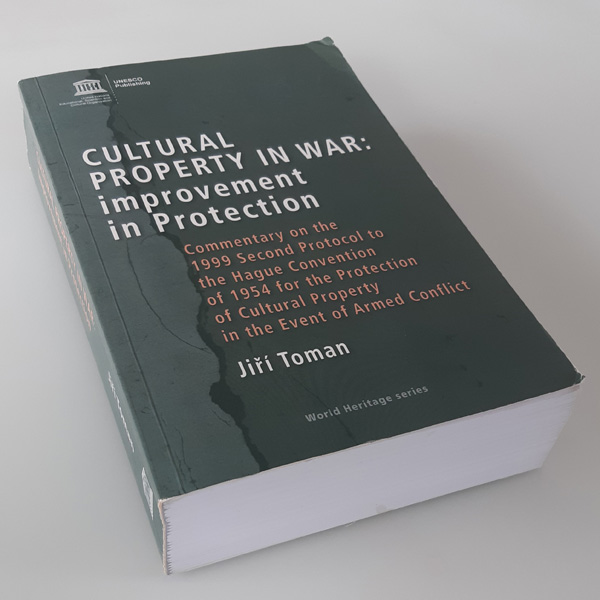26 March 1999 - 25 years ago, the Second Additional Protocol to the 1954 Hague Convention was adopted, what led to the strengthening the protection of cultural property in the event of armed conflict
On 26 March 1999, representatives of 27 states signed the "Second Protocol to the 1954 Hague Convention for the Protection of Cultural Property in the Event of Armed Conflict" at the conference in The Hague, thus declaring the text binding. With this solemn act, the Netherlands once again demonstrated its serious commitment to introducing humanitarian standards in the event of war: Almost exactly 55 years earlier (14 May 1954), the Hague Convention for the Protection of Cultural Property was adopted there; one hundred years earlier, in 1899, the first Hague Peace Conference was held in this city: Representatives of 26 states agreed at that time on the basic principles of humanitarian law in war and adopted the "Convention Respecting the Laws and Customs of War on Land", which regulated the treatment of the civilian population, spies, prisoners of war, and of the sick and wounded in war. These fundamental provisions are still valid today.
While respect for cultural property in armed conflicts was regulated in principle in the 1954 Convention, the atrocities committed in the Balkan wars in particular revealed the limits and weaknesses of the Hague Convention: The shelling of Dubrovnik in December 1991 (the old town was already a World Heritage Site at that time) and the destruction of the bridge in Mostar in 1993 (it was inscribed on the World Heritage List after reconstruction in 2005) were not only perceived with horror worldwide, but were also punished as war crimes with prison sentences by the "International Criminal Tribunal for the former Yugoslavia" in The Hague. In addition, the end of the Cold War offered new opportunities for co-operation in a climate of trust: the 1999 Protocol marked the beginning of a total of four cultural heritage agreements that were adopted within the UNESCO framework up to 2005.
The second protocol introduced a number of new regulations, such as the definition of "military necessity" that could justify an attack on cultural property, "enhanced protection" for World Heritage sites and individual offences; it also created a fund to finance protection measures and an intergovernmental committee to coordinate these activities.
The Protocol entered into force in 2004; to date, 88 states (out of around 200 states worldwide) have acceded to the agreement.
Austria (which ratified the text in 2002) contributed to the success of the Protocol: while it was still reluctant to ratify the 1954 Convention and the 1972 World Heritage Convention for many years (it only joined the 1954 Convention in 1964, and it took 20 years - 1992 - for the World Heritage Convention to be ratified), Austria invited the drafting conference to Vienna in 1998 and subsequently financed an Austrian expert to work at UNESCO on the Hague Convention. Austria's strong position at that time in the field of military cultural property protection (thanks to the close cooperation between the Ministry of Defence and the Ministry of Culture and with the NGO "Austrian Society for the Protection of Cultural Property") ultimately led to international recognition: when the intergovernmental committee started its work in 2007, the lawyer in the Austrian Ministry of Culture, Dr Christoph Bazil (now President of the Federal Monuments Authority), was elected Chairman of the Committee by the international community.
The JTC can claim that (former) employees of the center contributed to the creation of the protocol: Jiří Toman's comprehensive commentary on the 1954 Hague Convention served as a major support in the preparatory phase in identifying the weaknesses of the previous agreement. The author of this contribution - as a representative of the UNESCO World Heritage Centre at the drafting conferences in 1997 and 1998 - provided the experts with experience from the field of World Heritage (World Heritage served as a model and was therefore fully taken into account in the Protocol), and was constantly coordinating with the then Director of the World Heritage Centre, Bernd von Droste, on this important matter. Jiří Toman also remained closely involved with the second Protocol: in 2009, he published his extensive commentary on the Protocol (892 pages) with UNESCO, which is still considered a standard work today.
Peter Strasser
Queries
Further Reading
Jiří Toman: Cultural Property in War : Commentary on the 1999 Second Protocol to the Hague Convention of 1954 for the Protection of Cultural Property in the Event of Armed Conflict. Paris: UNESCO Publishing 2009 (ISBN 978-92-3-104142-6) (Englisch, überarbeitete Version auch auf Französisch erschienen: Les biens culturels en en temps de guerre : Quel progrès en faveur de leur protection ? Commentaire article-par-article du deuxième protocole de 1999 relatif à la Convention des biens culturels en cas de conflit armé. Paris: Éditions UNESCO 2015 (ISBN 978-92-3-200066-8))
Tags



